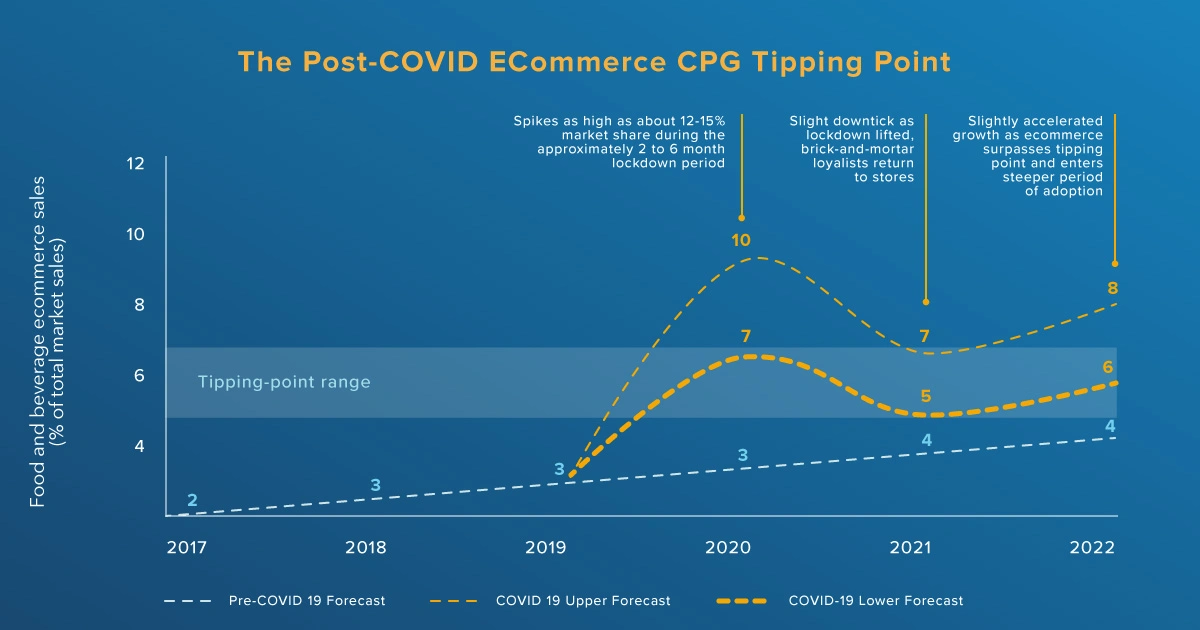
This Moment is Pivotal for CPGs and Wholesale Distributors alike
A virtual cup of coffee with Joel Cartwright - Consumer Products Industry Principal and David Schwartz - Director of Customer Success
By 2022, the ecommerce share of individual grocery categories is expected to be 3x higher than pre-COVID levels and 2x higher than pre-COVID forecasts.
Boston Consulting Group

Joel: Hi Dave, how are you?

David: I’m excellent! How are you?

Joel: I’m good! You know, I’ve been thinking a lot about the impact that ecommerce has had on CPG manufacturers, specifically to their market strategy planning for 2021. My question is, how and where are they promoting their products? The balance between ecommerce and in the store is what I am thinking about. What are you hearing?

David: Well, some of our customers already had an omnichannel strategy in place. While others are struggling and having to prioritize planning for online-shopping channels. I would say that the visionaries are in a better position to succeed.

Joel: How have our customers adapted to the ecommerce shift?

David: It’s been really painful! Some of our manufacturing customers were caught off guard from a planning standpoint. They were focused on getting and keeping product on the shelf. Our wholesale distribution customers were also unprepared because the shift has changed channel locations that lack the digital and technical capabilities to make their ecommerce portals work. This has forced an acceleration in wholesale distribution to adapt as well.

Joel: Do you think the impact to foodservice (B2B) and wholesale distribution is equal?

David: Just like in the retail market, the wholesale distributor has been forced to adapt in an accelerated way. I think a lot of organizations don’t know how to get started. Some of their challenges are related to their organizational structure. We see that the ecommerce component is scattered, not centralized throughout the organization.

Joel: I would agree. Do you believe that it is predominantly organizational or does technology play a part?

David: Technology is definitely playing a part, specifically around the idea of unified commerce.

Joel: What do you mean by unified commerce?

David: It’s a comprehensive suite that unites ecommerce, m-commerce, order fulfillment, and inventory management.

Joel: What type of advice would help our customers with short term objectives?

David: The way I see it, there are 3 questions to answer…
- Where’s my sales rep? One dramatic change is the reduction or elimination of using traditional direct sales representatives within foodservice distribution. Recent polls of independent restaurants show that prior to the pandemic 34.6% bought at least a portion of their restaurant supplies online. Restaurant owners have built relationships and trust with their foodservice distribution representatives, assuring restaurant owners of quality items and availability. Foodservice distributors and manufacturers can lose out on the opportunity to upsell or make deals with their customers.
- A case or a pallet? Historically, sellers buying directly through a distributor have been predominantly bulk buyers. Ecommerce provides better access for sellers to purchase, reducing the need for substantial inventory, orders could now come in small batches and even in single items.
- Does customer service knock off at 5? Definitely not. Because ecommerce portals do not
knock off at 5,
distributors and warehouses will need to shift to 24/7 operations. In addition, warehouses will have to be able to efficiently manage returns, which is a critical component in ecommerce. The process of reverse logistics is one of the biggest challenges brought to the B2B industry by ecommerce shift. And returned goods require not only additional labor and costs, but also a great amount of valuable warehouse space.

Joel: I agree, these are important considerations as CPGs and wholesale distributors navigate and plan for the future. Great catching up with you, Dave.

David: You too, Joel.
Are you ready for the post-COVID blip in time?
Get the latest news, updates, and exclusive insights from Vistex delivered straight to your inbox. Don’t miss out—opt in now and be the first to know!

